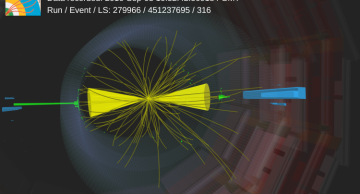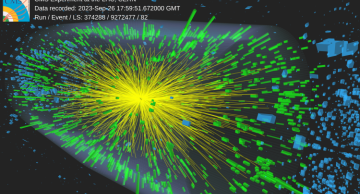Among all the elementary particles, quarks and gluons (partons) are the only ones that cannot be observed in isolation. In high-energy collisions, such as those occurring at the Large Hadron Collider (LHC), partons undergo a few stages between their…
News
|
sohurst |
Physics
The ATLAS and CMS Experiments at CERN have just released a new measurement of the mass of the top quark. The new result combines 15 previous measurements to give the most precise determination of the top-quark mass to date.
Among the known…
|
sohurst |
Collaboration
Yesterday at 7:46 pm the first stable beams of the LHC 2023 heavy-ion run have been recorded. The heavy-ion run allows CMS scientists to study states of matter similar to those of the early universe.
During this period, the CERN accelerators operate…
|
sohurst |
Collaboration
Every year, at least three young researchers within the CMS Collaboration are recognised for their exceptional efforts and achievements with the CMS Young Researcher Prize! It is not only an endorsement of their outstanding skills and dedication,…
|
nstathak |
Collaboration
New release of simulations, proton-lead collision data, and proton reference data
The CMS experiment's extensive collection of heavy ion data from LHC Run-1 (2010–2013) is now accessible through the CERN Open Data portal. Today’s release of proton-…
|
ajafari |
Physics
A new search conducted by the CMS collaboration is exploring Higgs bosons with very high energy. Measuring how many high-energy Higgs bosons are created in proton-proton collisions can tell us about new Higgs interactions, either with known…
|
ajafari |
Physics
Very quickly after quarks are produced in proton-proton collisions, they radiate gluons (the mediators of the strong force between quarks) that in turn produce more particles that radiate gluons. This creates an avalanche of particles in the…
|
ajafari |
Physics
Peter Higgs and François Englert received the Nobel Prize in Physics after the 2012 discovery of the Higgs boson with a mass of 125 GeV. Its existence provided experimental evidence of the predicted ‘Higgs field’ that pervades the universe and…
|
ajafari |
Physics
Most searches for new physics beyond the standard model (SM) focus on particles that decay almost instantly after being produced. However, many theories predict particles that travel a long distance, even up to meters, before decaying. Observing…
|
ajafari |
Physics
We have this idea that we communicate best within our own generation, but is this true? Who is to say that a second-generation lepton and a third-generation quark have nothing in common? Many observed phenomena in particle physics are conspicuously…
|
ajafari |
Physics
The CMS experiment at the LHC is set to explore the fundamental nature of our universe. It allows scientists to study particles, their interactions, and the forces that shape our world. Through these studies, a deeper understanding of the building…
|
fbaldass |
Detector
CMS has recently conducted the largest deletion campaign in its history, deleting roughly 85 Petabytes (85’000’000’000’000’000 bytes) of data from the magnetic tapes, in order to free up space for the Run 3 collisions. No original raw data…












